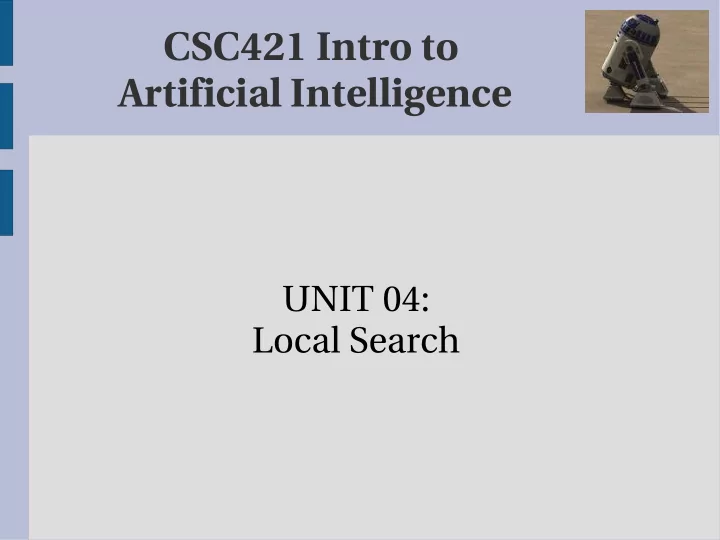

CSC421 Intro to Artificial Intelligence UNIT 04: Local Search
Review ● Heuristic functions estimate costs of shortest paths ● Good heuristics can dramatically reduce search cost ● Greedy best-first search expands lowest h – Incomplete, not always optimal ● A* search expands lowest g + h – Complete and optimal ● Admissable heuristics can be derived from the exact solution of relaxed problems
Map with step costs and straight-line distances to goal
Iterative improvement algorithms ● So far systematic exploration however ... ● In many optimization problems, path is irrelevant; the goal state itself is the solution ● State space = set of “complete configurations” – TSP, Timetable, 8-queens ● Iterative improvement algorithms – Keep single current state, try to improve it ● Constant-space suitable for offline and online search
Example: n-queens ● Put n queens on an n by n board with no two queens on the same row, column, or diagonal ● Move a queen to reduce # of conflicts Almost always solves n-queens problems almost instantaneously for very large n, e.g., n = 1 million
Hill climbing (or gradient descent) ● Like climbing mountain Everest in thick fog with amnesia
Hill Climbing Random restart hill climbing overcomes local maxima and is trivially complete Random sideway moves – escape from shoulders, trap at “flats”
Simulated Annealing Escape local maxima by allowing “bad moves” - decrease temperature (ammount of “moving” allowed”)
Local beam search ● Idea: keep k states instead of 1; choose top k of all their succesors ● Not the same as k searches run in parallel. Why ? ● Problem: quite often all k end up on same local hill ● Idea: choose k succesors randomly, biased toward good ones ● Observe the close analogy to natural selection
Genetic Algorithms ● Basically if stochastic beam search is asexual reproduction – genetic algorithms generate succesors from pairs of states
GAs continued ● GAs require states to be encoded as strings ● Cross-over helps iff substrings are meaningful component – From evolution: Good ears will still be good ears with a set of different legs ● GAs are not evolution (genes do not encode replication machinery) ● Main challenge to find representation ● Work well when – Good enough is ok – Few iterations can be afforded (for example user feedback)
Continuous State Spaces ● The “real” world ● Discretization ● Place 3 airports so that sum of sq. distances to all cities is minized Follow the gradient Typically numerically but sometimes: Constraint optimization harder: linear programming, quadratic programming
Online search problems ● Interleave computation & execution ● Exploration problems (robot placed on new planet go from A to B) ● Competitive ratio (can be infinite) – Actual cost compared to the cost of the path the agent would follow if it “knew” the search space in advance G G
Recommend
More recommend